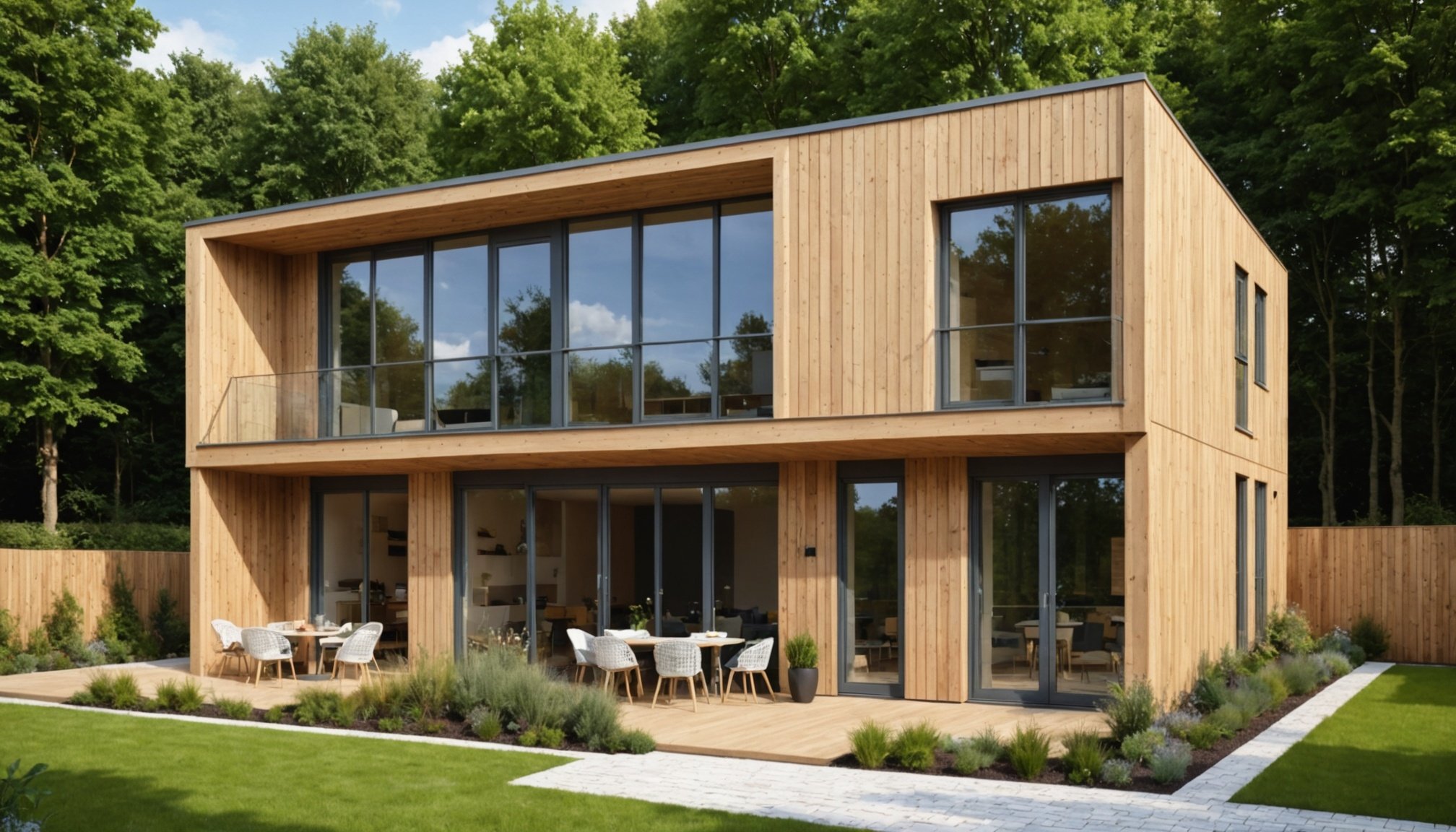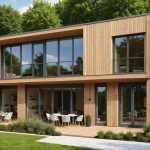Overview of Sustainable Building Materials
Sustainable materials are pivotal in eco-friendly construction, promoting a balance between environmental, economic, and social systems. These materials are defined by their ability to reduce negative impacts on the environment through their entire life cycle. This means they are sourced in an environmentally responsible way, manufactured with reduced energy and waste, and have a long-lasting lifecycle.
Sustainable building materials can be grouped into three primary categories:
This might interest you : Unlocking Tax Advantages: The Benefits of Investing in Sustainable Properties in Wales
-
Renewable materials: These include plant-based products like bamboo or cork, which can be rapidly regenerated and harvested in a sustainable manner.
-
Recycled materials: These are made from repurposed waste materials, such as recycled steel or glass, diverting waste from landfills while reducing the need for newly mined resources.
Have you seen this : Essential Factors to Consider When Investing in Properties Adjacent to New Transport Links in the UK
-
Non-toxic materials: These are free from harmful chemicals and pollutants, promoting healthier indoor air quality and reducing health risks associated with traditional construction materials.
The utilization of eco-friendly construction materials provides numerous benefits for both homeowners and builders. For homeowners, they offer improved air quality and energy efficiency, leading to potential cost savings on utility bills. Builders benefit from adhering to green building standards, potentially increasing property value and marketability due to growing consumer demand for sustainable materials. This approach fosters a healthier environment and supports a sustainable future.
Innovative Materials Transforming UK Homes
The construction industry in the UK is experiencing a revolution with the introduction of cutting-edge materials. These materials, like hempcrete and rammed earth, are not only eco-friendly but also enhance the sustainability of residential buildings. Hempcrete, a composite of industrial hemp fibers and lime, offers excellent thermal insulation, while rammed earth provides natural cooling benefits and long-lasting structural integrity.
Modern building practices are at the forefront of integrating these innovative materials by employing advanced technologies. 3D printing, for instance, is paving the way for sustainable material creation. It enables precise fabrication of custom construction elements, minimizing waste and optimizing resource usage.
Recent case studies highlight the successful application of these pioneering materials across the UK. A notable example includes a residential complex in Bristol that utilized hempcrete, resulting in reduced energy consumption. Another project in Scotland incorporated rammed earth, showcasing its effectiveness in creating naturally regulated indoor temperatures. These examples illustrate how combining cutting-edge materials with modern building practices can lead to environmentally conscious construction, while also meeting the functional and aesthetic demands of UK homes. This transformative approach not only benefits the environment but also provides homeowners with durable and energy-efficient living spaces.
Environmental Impacts of Sustainable Building
The role of sustainable buildings in achieving significant environmental benefits cannot be overstated. They primarily focus on energy efficiency and reducing the carbon footprint, which is crucial in today’s climate-conscious world.
Reducing Carbon Footprint
Sustainable building practices significantly reduce the carbon footprint by employing eco-friendly materials. These materials produce lower emissions compared to traditional building materials, thus decreasing the overall environmental impact. For instance, using recycled steel and reclaimed wood can minimize the amount of carbon dioxide released during construction.
Enhancing Energy Efficiency
Energy efficiency is a cornerstone of sustainable architecture. Structures are designed to utilize natural light, efficient insulation, and advanced HVAC systems, which collectively reduce energy consumption. These features not only lower utility bills but also contribute to lessening demand on non-renewable energy sources. By integrating renewable energy sources like solar panels, buildings can operate independently, further promoting energy conservation.
Supporting Biodiversity
Sustainable buildings support biodiversity by choosing materials that do not deplete local ecosystems. Thoughtful material selection, such as using responsibly sourced timber, ensures that building processes do not harm local flora and fauna. Additionally, incorporating green roofs and walls can create microhabitats, providing a refuge for various species, thus enhancing the symbiosis between urban environments and nature.
Cost Considerations and Financial Benefits
Building a cost-effective building involves more than just the upfront price tag. Initial costs may appear daunting, but the investment often yields significant long-term savings. Energy-efficient materials, for instance, can reduce utility expenses considerably over time. This enduring financial relief often offsets higher initial expenditures, making investment a savvy choice.
Government grants and incentives play a crucial role in fostering sustainable construction. These programs can significantly reduce the cost of building sustainable homes. Many regions offer tax credits or rebates to homeowners who utilize green building practices or install renewable energy technologies.
The economic benefits extend beyond utility savings. A cost-effective building also enhances property value. Sustainable homes are increasingly attractive to buyers, and the demand for eco-friendly properties drives up their market value. This means a cost-effective building not only saves money but also enhances investment returns should the property be sold.
Moreover, sustainable practices in construction can lead to a healthier living environment, potentially reducing healthcare costs associated with living in non-sustainable spaces. Thus, the comprehensive economic benefits of investing in eco-friendly construction are convincing for both individual homeowners and property developers.
Regulatory Guidelines and Building Codes
In the United Kingdom, building regulations play a crucial role in promoting sustainability by ensuring construction practices meet environmental standards. These regulations are comprehensive frameworks that address various aspects, including energy efficiency, resource management, and environmental impact. Adherence to these guidelines is vital for achieving sustainability goals, particularly when using eco-friendly materials. Compliance ensures that buildings not only meet safety and structural requirements but also contribute positively to environmental sustainability.
Code compliance is essential for homeowners and builders wanting to integrate eco-friendly materials into their projects. By following these regulations, they can guarantee that their constructions align with national sustainability targets and reduce their carbon footprint. Remaining informed about the evolving landscape of building regulations is critical, as they are periodically updated to reflect technological advancements and changing environmental priorities.
For those seeking resources, government websites and updates from environmental agencies provide valuable information on building regulations. These resources are designed to help builders and homeowners stay informed about current requirements and future changes. Additionally, numerous online platforms offer guidelines and tools to support compliance, thereby enabling more sustainable construction practices. Keeping abreast of these resources ensures that all stakeholders remain proactive in meeting sustainability standards.
Practical Tips for Sourcing Sustainable Materials
When sourcing materials for your project, finding eco-friendly suppliers is a crucial step. These suppliers offer resources that minimize environmental impact, supporting the overall sustainability of your endeavour.
Finding Local Suppliers
Local suppliers often provide a more sustainable option due to reduced transportation emissions. Begin by researching eco-friendly suppliers within your community. Word-of-mouth recommendations can be invaluable, as well as online reviews and sustainability certifications that demonstrate a supplier’s commitment to environmental practices.
Evaluating Materials
It’s vital to evaluate materials to ensure they meet sustainability criteria. Check for certifications like FSC (Forest Stewardship Council) for wood products or Cradle to Cradle (C2C) for various materials. These certifications help you make informed decisions, guaranteeing the materials’ eco-friendliness. Furthermore, consider the material’s lifecycle, ensuring it can be reused or recycled effectively.
Incorporating Sustainable Practices
Incorporating sustainable practices enhances the eco-friendliness of your project. Implement methods such as reducing waste by using precise measurements and selecting sourcing materials that require minimal processing. Additionally, engage with eco-friendly suppliers who provide guidance on best practices. Prioritizing these practices not only benefits the environment but can also lead to long-term cost savings.
By following these strategies, you’ll bolster the sustainability of your building process and contribute positively to environmental conservation.
Future Trends in Sustainable Building
The future of construction is rapidly evolving, driven by the need for lower environmental impact and resource efficiency. Innovative design and materials are predicted to be the cornerstone of this transformation. One such emerging material is self-healing concrete, which uses bacteria to fill cracks, extending the lifespan of structures and reducing maintenance costs. Similarly, cross-laminated timber is gaining traction as a sustainable alternative to traditional building materials.
Climate change poses significant challenges, prompting a shift in building practices. There’s a heightened focus on energy-efficiency and resilience against extreme weather conditions. Technologies like smart windows, which adapt to external weather changes, are becoming pivotal in this regard.
Additionally, there’s a discernible move towards a circular economy in construction. This involves reusing materials and designing for disassembly, ensuring that building components can be later repurposed. By prioritising resources’ life cycles, the industry reduces waste and capitalises on previously discarded materials.
The integration of these trends holds the promise of not just mitigating environmental impact but also potentially reducing construction costs. As these advancements take hold, adopting and investing in these technologies will be essential for building future-ready, sustainable structures.
Expert Opinions on Sustainable Building Practices
Delving into the realm of sustainable building, expert insights reveal a strong consensus about the need for widespread adoption of eco-friendly methods. Interviews with architects and builders underscore a growing trend: sustainability is not just an option—it’s a necessity. Today’s industry leaders provide a clear blueprint for sustainable housing projects, one that prioritises the environment while maintaining efficiency.
One notable perspective comes from a prominent architect who highlights the significance of material selection. According to them, using locally sourced and recycled materials can drastically reduce a building’s carbon footprint. This choice not only saves transportation energy but also supports local economies.
Builders, too, are making waves in sustainability. A head contractor from a leading firm stresses the importance of designing with solar energy in mind. By harnessing natural light and solar panels, homes can achieve greater energy independence, leading to reduced reliance on non-renewable resources.
Ultimately, industry leaders agree that collaborating with experts early in the project can avoid costly adjustments later. Those involved in sustainable housing projects should seek guidance from knowledgeable professionals to ensure their initiatives are both environmentally conscious and economically viable. Through these expert insights, sustainable building emerges as a practical and necessary choice for the future.











